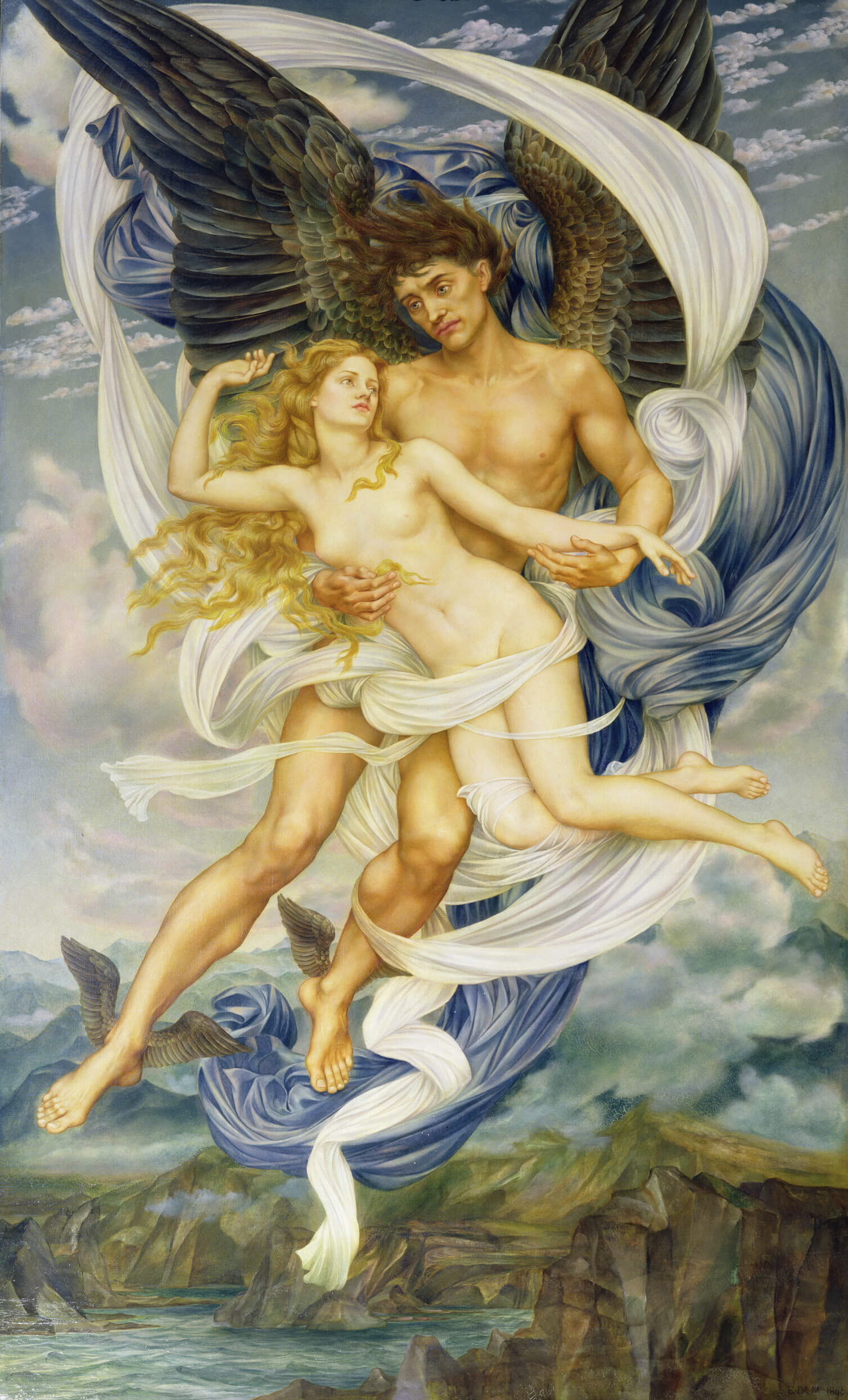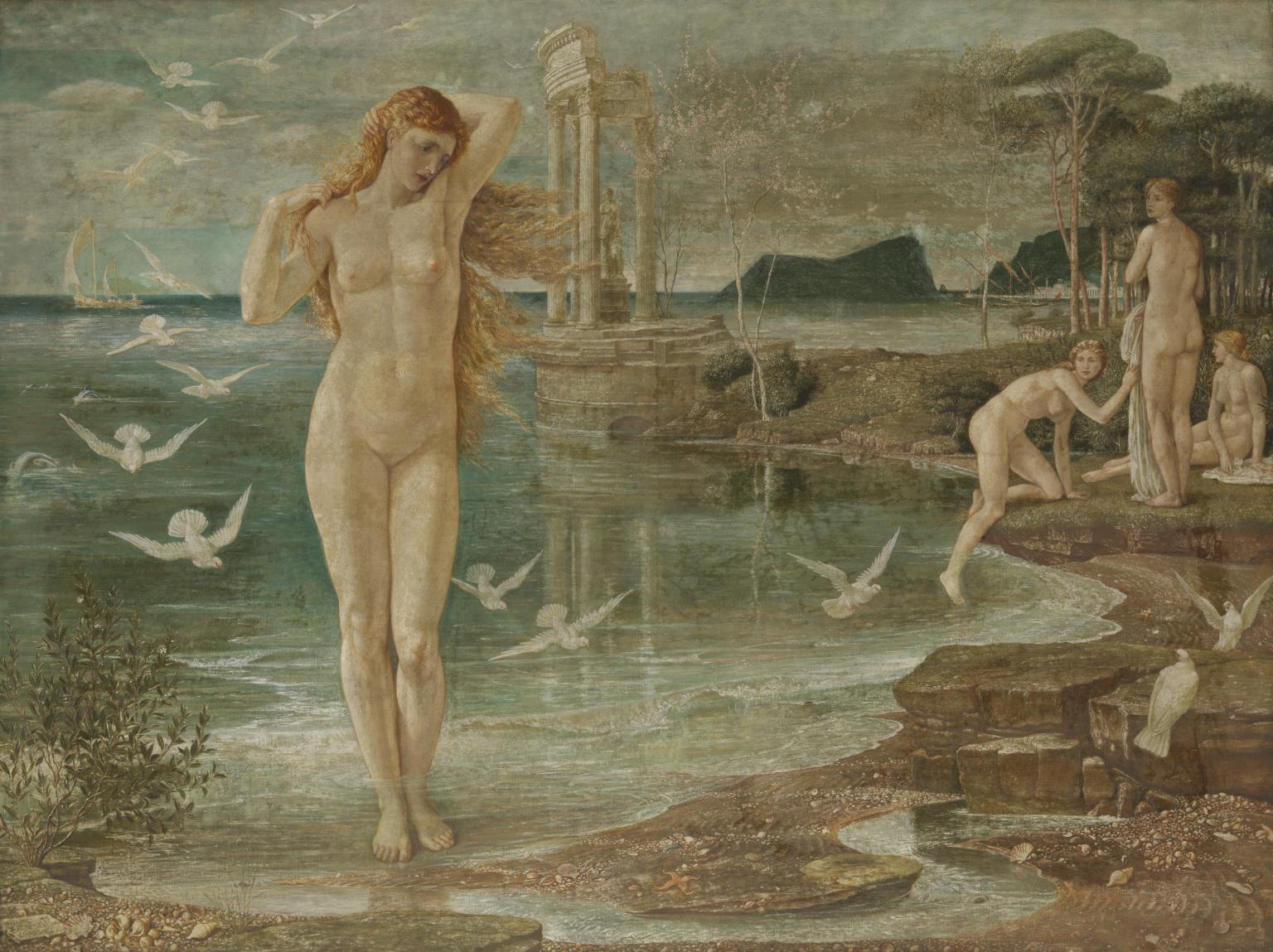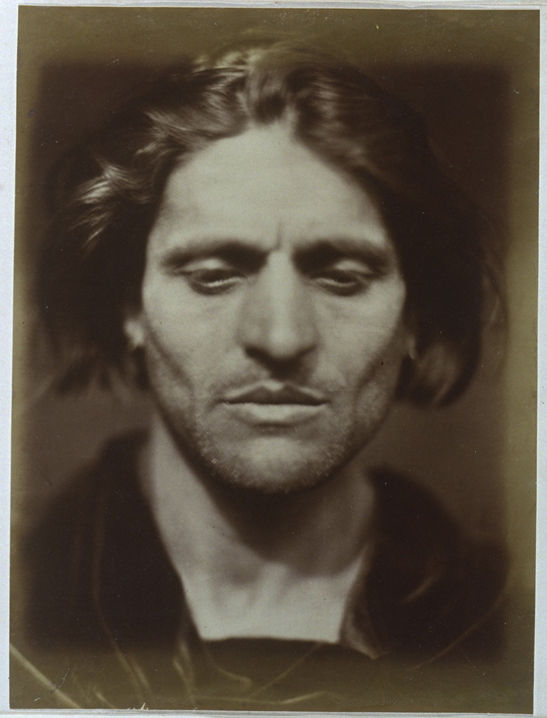This week, we are celebrating Evelyn De Morgan’s drawings. Whilst she is well known as a painter, her beautiful pencil and pastel studies are less well known, but certainly no less beautiful. In fact, many authors have commented on her talent as a draftswomen, often praising them as more accomplished than the oil paintings.
Volunteer Vanessa Cumper has taken a closer look at Evelyn De Morgan’s sketches of her favourite male model, Alessandro Di Marco.


Continuing with the De Morgan Collection curator’s Boreas and Oreithyia by Evelyn De Morgan (1896) challenge, I turned my attention to the charming study of the head of Boreas. The hair in the preparatory drawing has an almost combed appearance, in contrast to the finished painting of hair billowing around in the wind, I am sure to emphasise that he was the god of the north wind.
Last time I looked at the composition drawing, concentrating on Oreithyia, modelled by Jane Hales. Drawing from life was a taboo activity in prudish Victorian society, even for men. Walter Crane (1845-1915) painted The Renaissance of Venus in 1877 but was forbidden from painting naked female models by his wife. When Crane exhibited The Renaissance of Venus, Frederic Leighton proclaimed “my dear fellow, that is not Aphrodite – that’s Alessandro”. The Renaissance of Venus, was presented to the Tate Gallery by Mary Watts in 1913 as was the request of her late husband, George Frederic Watts. If you have the chance to visit it or study it online you will notice that Venus’ body is obviously male, particularly noticeable on the left outer edge under the arm, and around the ribcage.
Alessandro di Marco was a professional model painted by Evelyn and her contemporaries including George Frederic Watts (1817-1904), Edward Burne-Jones (1833-1898), George Howard, 9th Earl of Carlisle (1843-1911), and Walter Crane (1845-1915), amongst others.

The Renaissance of Venus 1877 Walter Crane 1845-1915 Presented by Mrs Watts by the wish of the late George Frederic Watts 1913 http://www.tate.org.uk/art/work/N02920
Identifying Alessandro
It is thought Alessandro di Marco was born around 1838-39, in the North Western Italian region of Piedmont. He modelled for Frederic Leighton (1830-1896) in Rome, four years later for Eduardo Rosales (1836-1873), who inscribed his portrait with Alessandro’s name and dated it 1857. We know that Alessandro was one of the artists’ models in London around 1870, moving from Paris during the Franco-Prussian war from the writings of Sir William Blake Richmond (1842-1921), specifically describing Alessandro as “a fellow so graceful and of such a colour, a kind of bronze gold” (Buckle 2012). William Hamo Thornycroft noted in his diary that Alessandro sat for long periods of time without a break, which would be a blessing for any artist working in any period, making that model in great demand.
Similar to Jane Hales, I have only been able to find one photograph of Alessandro di Marco, taken by Julia Margaret Cameron (1815-1879) in 1867, it is believed the print was given to her friend George Frederic Watts, to use for his painting of Iago (the evil character in Shakespeare’s Othello). The print of Alessandro has the title ‘Iago, Study from an Italian’, it is almost a life size print measuring 33.4 cm X 24.8cm and forms part of the collection of photos by Julia Cameron at the National Science and Media Museum in Bradford, however they have listed it as being a portrait of Angelo Colarossi.

Alessandro di Marco for ‘Iago’, by Julia Margaret Cameron
Controversy within academic circles surrounds the identity of Alessandro di Marco. Depending on which source you use Alessandro di Marco and Angelo Colarossi, are one and the same person or possibly different people with some suggesting they were brothers. Buckle (2012) has undertaken extensive research into Alessandro di Marco, identifying Angelo Colarossi as a moustachioed individual with quite differing features and wearing his hair short, but Alessandro wore his long, in sketches and paintings where he is identified he wasn’t sporting a moustache and was much thinner in the face than Angelo. I have tracked down one photograph which purports to be Angelo Colarossi (on Facebook) and is remarkably like the etching by Robert Bryden (1865 – 1939) inscribed by the artist as Angelo Colarossi with a date of ’89. The nose in both the photograph and the etching are completely different, to the photograph mentioned earlier taken by Margaret Cameron.
For my own curiosity I decided to sketch out both photographs of each of the models and wondered if this would give me any clues as to whether or not they were one and the same person, or related.
I worked from the photograph that Buckle (2012) says is Alessandro first. Using both a 2B and 4B pencil on A3 graphite paper I sketched out Alessandro. He has some very pleasing features that I think are timeless. I know Cameron did not start photography until she was in her late 40s, when she exhibited many criticised her ability, however I think the current consensus is that she was a very skilful photographer. Personally, I enjoyed her photographic style, the lighting and exposure she used, gave clear detail of Alessandro’s features.
![20200509_111908[1]](https://www.demorgan.org.uk/wp-content/uploads/2020/05/20200509_1119081-scaled.jpg)
Alessandro di Marco by De Morgan volunteer, Vanessa Cumper
![20200511_142840[1]](https://www.demorgan.org.uk/wp-content/uploads/2020/05/20200511_1428401-scaled.jpg)
Angelo Colarossi by De Morgan volunteer, Vnessa Cumper
Turning next to the photograph identified as Angelo Colarossi, the photograph is not as clear or lit as well as the one of Alessandro by Margaret Cameron. Using the same materials, I have sketched out Angelo’s features. I could not associate any of Angelo’s features to Alessandro’s, so a far as I feel they can not possibly be the same person. I personally feel that if they were brothers there would be something genetically the same which, even though they are different poses, I could not find. I would therefore conclude that they are different people entirely, but we might never learn more information about either’s background, because lives of artists models were not (and still not) well documented.
References:
Buckle. S. T. (2012) Is this the face of Alessandro di Marco? The features of a well-known Italian model. British Art Journal, Autumn 2012, Vol. 13 Issue 2, p67. https://www.academia.edu/3842470/Is_this_the_face_of_Alessandro_di_Marco_The_forgotten_features_of_a_well-known_Italian_model
Drawmet. L. J. B. (2013) Dictionary of Artists’ Models. Routledge
James. R. (2011) Pocket Guide to Victorian Artists and their Models. Pen and Sword Books. South Yorkshire.
Squire. H. (2019) Look Beneath the Lustre. Wightwick Mannor. https://www.demorgan.org.uk/wp-content/uploads/2019/11/Completed-Exhibition-Folder-Look-Beneath-the-Lustre-explore-book.pdf






